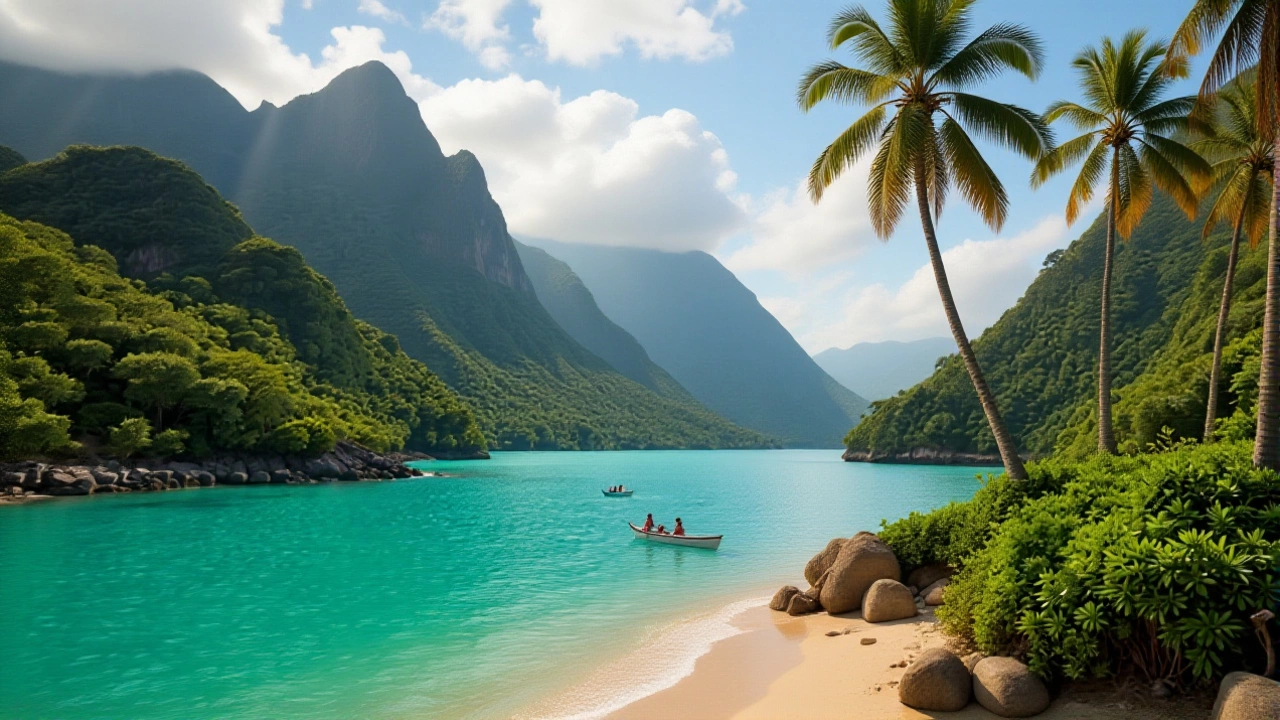
When Brazil welcomed over 7 million international tourists in the first three quarters of 2025 — a 45% leap from 2024 — it didn’t just join the ranks of Latin America’s top destinations. It rewrote the playbook. Alongside Mexico, Colombia, Chile, and Caribbean powerhouses, Brazil’s surge is no fluke. It’s the result of new air routes, bold marketing, and a cultural renaissance that’s pulling travelers back — and staying longer. The numbers don’t lie: the World Travel & Tourism Council (WTTC) and Visit Latin America confirmed in November 2025 that the region is on track to shatter every tourism record ever set.
Why Brazil Is Suddenly Everywhere
Brazil’s 45% jump isn’t just about Carnival. It’s about connectivity. Airlines like LATAM and Azul added 27 new international routes in 2024 and 2025, linking São Paulo and Rio directly to cities like Toronto, Madrid, and Tokyo. The FIFA Club World Cup in June 2025 — held across Rio, Belo Horizonte, and Salvador — wasn’t just a sporting event. It was a global billboard. Hotels in Porto de Galinhas and the Amazon’s eco-lodges reported 60% occupancy rates through September. And here’s the twist: most visitors aren’t just passing through. They’re staying 11 days on average — up from 8 in 2023.
The Regional Leaders: Who’s Winning and How
Mexico still leads with 9.55 million visitors in 2025, but its growth has slowed to 3.1%. The secret? It’s no longer just Cancún and Cabo. Cities like Oaxaca and Mérida are drawing foodies and digital nomads with curated heritage tours and co-working spaces in colonial mansions. Meanwhile, Colombia saw 3.1 million visitors through August — a 5.3% rise — with Bogotá, Medellín, and Cartagena becoming hubs for sustainable urban tourism. Backpackers now book multi-week stays, hopping between coffee farms, street art walks, and rooftop yoga studios.
Chile posted a jaw-dropping 32% growth in the first half of 2025. Why? New direct flights to Patagonia from Miami and Frankfurt, plus the reopening of the Carretera Austral after flood repairs. Tourists aren’t just hiking Torres del Paine — they’re staying in solar-powered lodges and joining Indigenous Mapuche-led cultural workshops. And then there’s El Salvador, the dark horse. With an 81% tourism surge, it’s become the surf capital of Central America. Tamarindo and El Tunco now draw 20-somethings from Germany and Australia who tweet about “volcanic sunsets and $12 beachfront tacos.”

The Money Behind the Magic
The numbers are staggering. In 2024, Latin America’s travel industry generated $67.9 billion in gross bookings. By 2025, that’s projected to hit $79.2 billion — a 17% jump, according to Phocuswright. But that’s just the start. The broader Latin America Travel Market is expected to grow from $107.82 billion in 2024 to $208.44 billion by 2033, per IMARC Group. International visitor spending hit $144.4 billion last year — more than Brazil’s entire agricultural export value.
And it’s not just about hotels. Amadeus reported a 6% year-on-year surge in South American air traffic from July 2024 to June 2025. Colombia’s air growth is at 5.6%, Mexico’s at 4.5%, and Brazil’s at 2.1%. By 2026, regional passenger traffic is expected to hit 821 million. The Economic Commission for Latin America and the Caribbean (ECLAC) revised its 2025 GDP forecast upward to 2.4% — largely thanks to tourism’s ripple effect on retail, food services, and transport.
Who’s Traveling — and Why
Couples make up the biggest chunk of visitors in Costa Rica (43%) and Ecuador (36%), lured by jungle retreats and wine tours in the Andes. Families dominate in Mexico and Brazil, where theme parks and beach resorts are packed. But the real shift? Cultural depth. Travelers aren’t just checking off landmarks. They want to cook with a churrasqueiro in Porto Alegre, learn samba from a community school in Rio’s favelas, or join a guided birdwatching tour in the Ecuadorian cloud forest.
That’s why UN Tourism and CAF launched the Green Projects Innovation Challenge in February 2024. From eco-lodges powered by biogas in Bolivia’s Uyuni salt flats to coral restoration programs off the coast of the Dominican Republic, sustainability isn’t a buzzword — it’s a business model. And it’s working.

What’s Next? The Task Force and the December Deadline
The WTTC-IDB Tourism Task Force, announced in Santo Domingo on May 29, 2025, is now drafting policy recommendations to scale this growth responsibly. Their mandate? Secure private investment, streamline visa processes, and protect natural sites from overtourism. The final blueprint drops at the CEO Summit of the Americas in Punta Cana in December 2025.
By 2035, WTTC forecasts tourism will contribute $944.8 billion to Latin America’s economy and support over 35.4 million jobs. That’s 6 million more jobs than in 2025. The question isn’t whether this growth will continue — it’s whether governments will act fast enough to make it inclusive, sustainable, and lasting.
Frequently Asked Questions
How is Brazil’s tourism boom different from Mexico’s?
Brazil’s growth is driven by new international air routes and major events like the FIFA Club World Cup, pulling in longer-staying travelers seeking cultural immersion. Mexico still leads in total visitors, but its growth is steadier, fueled by diversified destinations beyond beach resorts — think Oaxaca’s food scene and Mérida’s heritage tourism. Brazil’s 45% surge in 2025 is sharper, while Mexico’s 3.1% growth reflects market saturation.
Which countries are leading in sustainable tourism investments?
Brazil, Costa Rica, and Ecuador are investing heavily in eco-lodges, protected zones, and community-led tourism. Brazil’s Amazon conservation projects now host over 120 certified eco-lodges. Costa Rica generates 95% of its air capacity for inbound travelers, prioritizing low-impact tourism. Ecuador’s Galápagos Islands enforce strict visitor caps and carbon-offset programs, while Bolivia’s Uyuni salt flats now use solar-powered visitor centers.
Why is El Salvador’s tourism growth so surprising?
El Salvador’s 81% tourism jump stems from digital-first marketing targeting Gen Z and millennial surfers. With affordable prices, consistent waves, and viral TikTok content from its Pacific coast towns, it’s become a hidden gem. Unlike traditional destinations, it didn’t rely on big airlines or government campaigns — just authentic social media storytelling and low-cost, high-impact infrastructure like surf hostels and beachside co-working spaces.
How will the WTTC-IDB Tourism Task Force impact travelers?
The task force aims to simplify visa policies, improve regional air connectivity, and fund green infrastructure. Travelers may soon see streamlined entry across multiple Latin American countries, more eco-certified accommodations, and reduced flight delays thanks to coordinated airport upgrades. Their December 2025 report could lead to a unified Latin American tourism passport — a game-changer for multi-country trips.
What’s the economic impact beyond hotels and flights?
Tourism fuels everything from local crafts to food supply chains. In Colombia, 68% of artisanal coffee producers now sell directly to tourists. In Peru, Andean weavers saw a 40% income boost from cultural tours. The $144.4 billion in international spending in 2024 supported small businesses, transportation networks, and even public health clinics in tourist zones. It’s not just revenue — it’s economic resilience.
Is overtourism a risk in these growing destinations?
Yes — especially in places like Machu Picchu, Cartagena’s Old Town, and Brazil’s Fernando de Noronha. But many are acting preemptively. Ecuador limits Galápagos visitors to 20,000 per month. Chile caps Patagonia trail access. Brazil’s environmental agencies now require eco-certification for new resorts. The goal isn’t to stop growth — it’s to make it smarter, so local communities benefit without losing their culture or environment.


